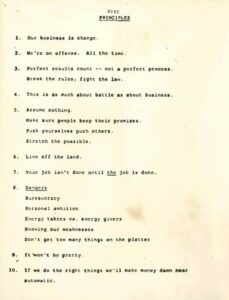The post was originally published in Polish on Artur’s LinkedIn profile. Artur kindly agreed that we repost what we think is of great value to our readers.
You may have noticed in the movie Air (about which I wrote recently) how the camera zooms in on the ten principles of Nike hanging on the wall of CEO Phil Knight’s office. Are you wondering where it came from and who is its author?
I got terribly interested, so I dug a little bit of history.
In 1977, Nike, then known as Blue Ribbon Sports, was on the brink of collapse. In spite of the growing sales of USD 28.7M, employing fewer than 1,000 people, and not yet being a public company, the company faced a USD 25M debt due for unpaid duties on athletic shoes.
Nike’s CEO and co-founder at the time, Phil Knight, admitted that having to pay that amount could bankrupt the company.

Nike’s 10 Key Principles
At this crucial juncture, Nike board member Rob Strasser drafted 10 key principles. These were rules that included directives such as ‘Break the rules; fight the law,’ or ‘It’s not going to be pretty.’ They embodied the rebellious spirit and competitiveness of the early Nike team.
This list has recently gained traction on social media, highlighting Nike’s difficult beginnings.
Its influence on the company was so great that a 1985 article in a local newspaper, Willamette Week, called him the man who saved Nike.’
The memo has been kept by several former Nike employees who consider it a reflection of the company’s core values.
Knight didn’t know about the note before it was written, but he later appreciated Strasser’s communication skills. Knight’s relationship with Strasser, however, became strained after Strasser left Nike in 1987 to join Adidas, a direct competitor. Strasser’s move was seen by Knight as an ‘unacceptable betrayal.’ Despite the grief expressed in their memoirs, Knight and Strasser never reconciled until Strasser’s death in 1993.
In 2001, Nike introduced a set of 11 corporate ‘maxims,’ which were later revised and reduced to five in 2018. One of the maxims, ‘Always on the Offensive,’ pays homage to Strasser’s original principles and continues to be a favorite mantra among Nike executives.
The company went public in 1980 and its revenue grew to USD 270M, and Strasser influenced it in some part. In the same year, the company managed to settle a customs dispute of USD 9M.
Thus Nike has evolved from struggling to stay afloat into a USD 179B global sportswear giant with 75,000 employees.

Creator, entrepreneur and investor – I write about my experiences with startups, technology and business.





